
10 Myths of Credit Repair
Myth #1: When I pay off a past-due account, such as a Charge Off or a Collection Account, it will be listed as “paid” and no longer be reported as negative.
Myth #2: If a negative item is successfully deleted from my credit report, it will reappear on my report.
Myth #3: There are items such as bankruptcies, foreclosures, and tax liens that are impossible to remove from the credit report.
Myth #4: Disputing a credit report is easy — any consumer can do it themselves.
Myth #5: The credit bureau allows me to submit my 100-word explanation. Creditors will read my statement and take it into consideration.
Myth #6: The credit bureaus are a branch of the government, infallible, and above reproach.
Myth #7: I can create a totally new credit file by getting a federal tax ID number or changing a few numbers on my social security number.
Myth #8: If I build enough good credit, it will offset my bad credit and make me credit worthy.
Myth #9: Nonprofit organizations like Consumer Credit Counseling Service (CCCS) can help me restore my credit.
Myth #10: It is illegal for creditors to take a negative, accurate listing off my credit report. The law requires that these items remain on the credit report for at least seven (7) years.
Myth #1:
When I pay off a past-due account, such as a Charge Off or a Collection Account, it will be listed as “paid” and no longer be reported as negative.

Click the image
to watch the video! |
It is difficult to fully restore your credit if your outstanding debts have not been paid. However, paying off a debt can actually hurt your credit. Negative items on your credit report are allowed to stay on your credit report for a maximum of 7 years, except for a bankruptcy which can remain on your report for up to ten 10 years. This 7 or 10 year clock begins ticking on the last “entry” date of activity, meaning – If you were to make a payment, it automatically is presented as “new activity” thus, the clock is restarted. to make a payment, it automatically is presented as “new activity” thus, the clock is restarted. When paying an outstanding debt, you will change the account status to a “Paid Collection”, “Paid Charge-Off”, “Satisfied Judgment”, or “Paid” but, X amount of days late”. This is still considered as negative activity and appears as though you were “strong-armed” by the credit bureau to pay the account. It is almost always prudent to hire a professional assistant to prevent further damage to your credit although you were simply attempting to do the right thing. |
|
|
Myth #2:
If a negative item is successfully deleted from my credit report, it will reappear on my report.

Click the image
to watch the video! |
The credit bureaus have cleverly and purposely spread this myth through the news media and government agencies. However, the truth of the matter is the credit bureaus will often temporarily delete a negative listing if they have not heard from the credit grantor within 30 days since an item was disputed. Should the credit grantor submit verification a week or two later,
it will be re-inserted — This is called a “soft delete”. Most of the time the creditor simply fails to respond and the negative item is permanently deleted. If the creditor verifies the item the account may still be deleted at a later date when the “challenge” process is intensified. |
|
|
Myth #3:
There are items such as bankruptcies, foreclosures, and tax liens that are impossible to remove from the credit report.
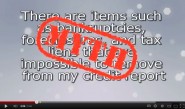
Click the image
to watch the video! |
There is NOTHING in the law that states a negative item must remain on a credit report for any period of time. Our attorneys have experience in removing every type of negative item from our members’ credit reports. |
|
|
Myth #4:
Disputing a credit report is easy — anyone can do it themselves.
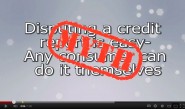
Click the image
to watch the video! |
Disputing a credit report is easy. However, getting results from the credit bureaus as a “layperson” is amazingly difficult, complex, and infuriating. The Federal Trade Commission receives more complaints against credit bureaus than any other type of business. In February 2000, the 3 major credit bureaus paid a 2 million dollar fine for ignoring consumers after they requested information regarding their files. Remember, the credit bureaus are primarily interested in protecting their profits. Investigating consumer disputes consumes these profits. Sparking an enormous number of lawsuits, the bureaus do everything in their power to impede any progress you might attain when attempting to restore your own credit. Trying to restore your own credit is likened to blindly representing yourself in a court of law. Restoring your own credit is like repairing your own transmission or representing your self in court. It is possible, but you have to be willing to invest a great deal of time educating yourself about the law, courtroom procedures, etc. You will also assume the risk of your inexperience by realizing it will take you much longer than you expected and even more important; your own efforts will be less effective than that of a professional. |
|
|
Myth #5:
Credit bureaus allow me to submit a 100 word explanation. Creditors will read my statement and take it into consideration.
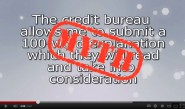
Click the image
to watch the video! |
Not so! This statement only verifies some of the negative items on your report. Your explanation should be the FIRST thing deleted from your credit file. No creditor will consider the information submitted in your statement. |
|
|
Myth #6:
Credit bureaus are affiliated with the government, infallible, and above reproach.
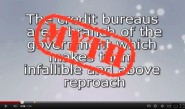
Click the image
to watch the video! |
Credit bureaus are publicly traded companies in business to impress stockholders – They are not government agencies. They are one of the most heavily regulated industries. The strict regulations stem from a public outcry of abuse and mistakes. A recent survey by an independent research group revealed more than 70% of credit reports contained mistakes or errors. The prevalence of errors led to consumer protection legislation that allows consumers to challenge the bureaus and force the removal of inaccurate, outdated or unverifiable information. |
|
|
Myth #7:
I can create a totally new credit file by getting a Federal Tax ID number or changing a few numbers on my social security number.
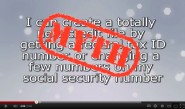
Click the image
to watch the video! |
This fraudulent scheme is complex, but more importantly — ILLEGAL. Lying on a credit application is a criminal offense. With modern technology linking computer systems, it is virtually impossible to pull off. It is in your best interest to hire adequate representation and confront the credit bureaus armed with the “rights” congress granted YOU through the consumer protection laws. |
|
|
Myth #8:
If I build enough good credit, it will offset my bad credit and make me credit worthy.
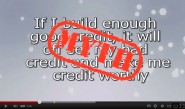
Click the image
to watch the video! |
The slightest amount of bad credit is devastating to your chances of being approved by a creditor. The approval is almost never in the hands of a human sitting at a desk across from you — An approval is derived from a computer achieving a “point” total. Generally, even the slightest amount of negative credit (regardless of the amount of good credit) will result in a declination. |
|
|
Myth #9:
Nonprofit organizations like Consumer Credit Counseling Service (CCCS) can help me restore my credit.
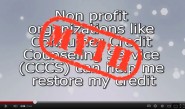
Click the image
to watch the video! |
Nonprofit debt counseling services assist people who are in debt over their heads and seeking an alternative to bankruptcy. CCCS are funded and controlled by credit grantors and credit bureaus. When you are working with CCCS your creditors will often note this on your credit report. This is a huge red flag for prospective credit grantors. Some of the very worst credit reports we see are participants in CCCS or similar programs. |
|
|
Myth #10:
It is illegal for creditors to remove a negative, “accurate” listing off my credit report. The law requires that these items remain on the credit report for at least 7 years.
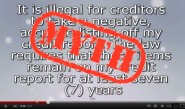
Click the image
to watch the video! |
When you speak to credit grantors, collection agencies or credit bureaus, their typically uneducated staff may tell you all kinds of pseudo-legal nonsense. The law limits negative information from appearing longer than the legal 7 year maximum. The credit grantor or credit bureau can delete the item if they choose to. |
|
|











